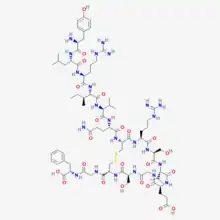
Chemical structure of hGH Fragment 176-191
Human Growth Hormone Fragment 176-191 (hGH frag 176-191) is a lipolytic peptide fragment of human growth hormone.[1] Human trials show that it retains the lipolytic properties of human growth hormone without stimulating IGF-1 production.[2] Unlike human growth hormone, Human Growth Hormone Fragment 176-191 lowers blood sugar levels.[3]
Mechanism of action
hGH frag 176-191 appears to enhance lipolysis by upregulating beta-3 adrenergic receptors. Beta-3 adrenergic receptor knockout mice are unresponsive to the lipolytic effects of hGH frag 176-191.[4]
References
- ↑ Heffernan, M. A.; Jiang, W. J.; Thorburn, A. W.; Ng, F. M. (2000-09-01). "Effects of oral administration of a synthetic fragment of human growth hormone on lipid metabolism". American Journal of Physiology-Endocrinology and Metabolism. 279 (3): E501–E507. doi:10.1152/ajpendo.2000.279.3.E501. ISSN 0193-1849.
- ↑ Stier, Heike; Vos, Evert; Kenley, David (2013-04-23). "Safety and Tolerability of the Hexadecapeptide AOD9604 in Humans". Journal of Endocrinology and Metabolism. 3 (1–2): 7–15. doi:10.4021/jem.v3i1-2.157. ISSN 1923-287X.
- ↑ Ng, F. M.; Bornstein, J. (May 1978). "Hyperglycemic action of synthetic C-terminal fragments of human growth hormone". The American Journal of Physiology. 234 (5): E521–526. doi:10.1152/ajpendo.1978.234.5.E521. ISSN 0002-9513. PMID 645904.
- ↑ Heffernan, M.; Summers, R. J.; Thorburn, A.; Ogru, E.; Gianello, R.; Jiang, W. J.; Ng, F. M. (December 2001). "The effects of human GH and its lipolytic fragment (AOD9604) on lipid metabolism following chronic treatment in obese mice and beta(3)-AR knock-out mice". Endocrinology. 142 (12): 5182–5189. doi:10.1210/endo.142.12.8522. ISSN 0013-7227. PMID 11713213.
This article is issued from Wikipedia. The text is licensed under Creative Commons - Attribution - Sharealike. Additional terms may apply for the media files.